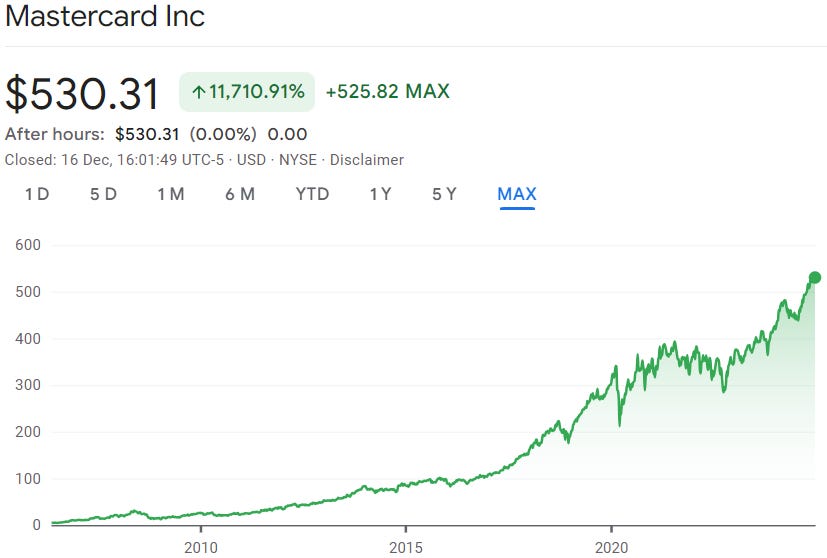Understanding Companies
Hello fellow Dividenders!
Right, let's have a proper chat about how I go about choosing dividend paying companies. It's not about chasing the biggest yield. I'm in it for the long haul. I see the stock market as this incredible opportunity to own a slice of something real, to become a partner in a great business. It's not about "holding stock" like some short-term speculator; it's about investing in a company I believe in and sharing in its success.
A truly great company is more than just a money-making machine. It's got a strong culture, a great set of values, and a top-notch management team at the helm. These things are crucial, not just for the numbers we see in those quarterly reports, but for the long-term health and growth of the business. They're the secret sauce that sets the great companies apart.
And that's why I believe in really getting to know a company before I invest a penny. I dig deep into their filings, not just for the last quarter or year, but for the past decade. I want to see the full picture, how they've evolved, the strategies they've pursued, the commitments they've made, and how they've delivered on them.
By tracing this history, I can get a real feel for the management team. Are the key figures still there, guiding the ship? If not, are the new lot building on the good work of their predecessors? This kind of long-term perspective is essential, in my view.
So, before I even start thinking about valuations, I spend a good chunk of time immersed in company reports. Of course, I do a bit of initial screening to weed out any obvious no-nos, you can check my foundational stock screener, but then it's all about delving into those filings and getting to know the business inside out.
Getting to Know the Business Inside and Out
First things first, I want to understand exactly what makes the company tick. What do they actually do? Are they grafting away making things, shifting products in shops, or offering some kind of service? Figuring out their place in the market is key, so I look at their sector and industry. This helps me see how they stack up against the competition and understand the trends and rules that might affect them.
And speaking of competition, I always like to know who they're up against. Who are the big players in their field? What are they good at, and where are their weaknesses? The company I'm looking at needs to have something special, something that sets them apart from the crowd.
Of course, I pore over the financials. It's not just about the dividend, dividend growth, yield and payout levels; More importantly I want to see the quality of the business engine: healthy revenue and earnings growth, nice juicy profit margins, and manageable debt. Cash flow is crucial – it's the lifeblood of any business, funding those dividends and future growth. A good return on invested capital (ROIC) shows me that management knows how to allocate capital effectively to boost returns.
Every business faces risks, and I spend time thinking about what could go wrong. There might be company-specific risks, like relying too much on one product or customer, or maybe they're at risk from new technology or changing tastes. Then there are the bigger economic factors, like recessions, interest rates going up, inflation, or even global events causing trouble.
Great businesses with great culture and top management tend to mitigate micro and macro risks well in the long term. But my capital allocation might be cautious in the short term depending on the risks I see.
More Than Just Numbers: Culture and Management Matter
Now, it's not all about spreadsheets and numbers. A company's culture and the people running the show are just as important. I want to see a company with strong values, one that's doing right by society and communities they’re part off. Those are the kind of companies that attract good people and build strong relationships with customers, which is good news for long-term success.
To get a feel for what it's like to work there, I have a peek at employee reviews on sites like Glassdoor. Happy, engaged employees are usually a good sign. I also try to get a sense of the workplace atmosphere. Is it a place where people feel respected and can speak their minds, or is it a bit toxic?
The management team needs to be top-notch. I do my homework on their backgrounds, experience, and track record. If I can, I try to get a sense of their values and how they lead. I've got a soft spot for founder-led businesses; they often have that extra bit of passion and commitment. And I like to see "skin in the game" – when management owns shares, it shows they're in it for the long haul. Glassdoor can be handy for checking what employees think of the CEO and the top brass, too.
Valuation: A Sensible Approach
When it comes to valuation, I like to keep my feet on the ground. I use the price-to-earnings (P/E) ratio to see how the company's valued compared to its rivals, its own history, and the rest of the industry.
I don't use classic DCF or the Dividend Discount Model (DDM). Instead, I find reverse discounted cash flow (DCF) more helpful. It helps me work out what kind of growth is baked into the current share price, so I can compare that to my own expectations. I also "consult" the PEG ratio, which looks at P/E and earnings growth together, but I never make a decision based purely on this.
Let's be honest, trying to predict the future is a mug's game. Any valuation relies on guesswork, and things might not pan out as expected. What something's "really" worth is subjective – it's all down to my own view of the company and its future.
The key in terms of valuation is about minimizing risks, as Warren Buffett said, "Rule No. 1 is never lose money. Rule No. 2 is never forget Rule No. 1". You are closer to that if you choose to invest in great companies at reasonable prices – reasonable compared to the industry, the market cycle, and the company's own history. If that's not the case for a company I really wanted to be a partner with today, there's always the "add to watchlist" button. Patience is a virtue, and the right opportunity will come along.
The Long and Short of It
So there you have it – that's how I go about choosing my business partners. It's a thorough process, looking at the business from all angles, from the nitty-gritty financials to the culture and the people in charge. I can't guarantee success, but this approach helps me make informed decisions and build a portfolio that should stand the test of time.
Until next time,
The Dividend Edge








